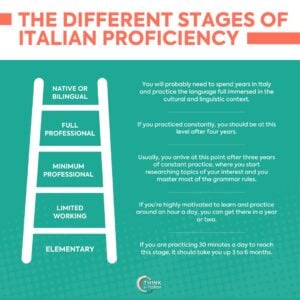Download the list
In a hurry? Download a PDF with the list of the most common Italian verbs!
Just tell me where I should send it in the form below.
Where should I send it?
Download instantly and receive a wealth of free resources. Opt out at any time.
What is verb conjugation?
What is verb conjugation, anyway? And why do you need to learn verb conjugation to speak Italian?
In a nutshell, verb conjugation is the process of changing a verb in some way to indicate different meanings, such as the person or number of people acting.
In simplest terms, conjugation is when you turn a verb like “run” into “ran”, ”running,” or ”will run”—depending on what it is exactly you mean.
In Italian, this is done by changing the ending of the verb.
In practice, this means that verbs like ‘cook’ or ‘talk’ will have different endings depending on who is performing the action.

Verb conjugations are relatively limited in English.
However, in Italian, they’re pretty obvious and it’s impossible to overlook them.
There are several different Italian verb tenses (and even moods) that can change the way a verb is formed in Italian.
In this post, you’ll learn the basic conjugations to get you started in Italian, as well as the best ways to practice conjugations.
Yes! Italian conjugation explained!
Italian verb conjugation: a nightmare?
Even the most passionate and dedicated language learners tend to groan when the time comes to work on conjugations.
It’s a dreaded part of learning the language that conjures images of frustrating conjugation tables and long nights spent attempting to memorize endless lists of words.
Conjugating Italian verbs is not fun. And when you’re starting, it can take a ton of concentration.
But if you’re feeling intimidated, well… don’t be!
With a bit of practice, you’ll realize that Italian verb conjugation is much less difficult than it seems at first.
In fact, once you begin to understand the patterns in each tense, it’s pretty easy.
Don’t worry! This post will get you back on track and help you have a healthier attitude on the subject.
Italian verb tenses and conjugations are hard, but not impossible.
The problem with teaching verb conjugations
It haunts the nightmares of Italian language learners. Many would rather ride a roller-coaster with cobwebs for seat belts than face a wall of conjugations that reads like a foreign language unto itself.
Granted, the subject of conjugations isn’t easy, and admittedly, Italian is a bit harder than English.
But that said, conjugation is still not as hard as it’s made out to be.
I think there are three major problems in the approach to the subject that we need to correct here.
Too much theory, too little practice
Many textbooks give a chapter or two to this topic as if that’s enough. And the lessons, when they’re taught, are delivered too fast.
It’s one of those things that’s easy for the teacher to teach but very hard for the students to master.
Conjugation is a big, fat topic.
It’s like a catch-all subject that combines everything you’ve ever learned about Italian grammar—pronouns, tenses, nouns, genders, subject-verb agreement, sentence structure, and so on.
Too many rules, too few examples
Another mistake that Italian learners make is that they think they can “hack” the subject by memorizing a table of rules written on an Italian verb conjugation table.
Personally, I never study tables of rules and conjugations.
Tables and matrices lack real-world context, which gives nuance to your understanding. That’s why most people forget what they read on those tables pretty quickly.
Context makes things vivid. It’s like seeing things in action.
So, study verbs in sentences instead of using a conjugation verb tool.
Instead, I recommend learning by speaking with an Italian audio course like Ripeti Con Me.
You can also repurpose the language content you’re already using—like songs, rhymes, audiobooks, and short stories—for learning conjugation.
Read or listen while paying attention to how the verbs are used.
Mistakes and expectations
We learn verb conjugations by trial and error.
However, many students are afraid of making mistakes.
That’s a huge hindrance to progress.
On the other side, some expect to be able to speak correctly only because they know the rules.
Unfortunately, that doesn’t happen.
You need practice. A lot!
So, don’t worry about making mistakes. We learn by making plenty of them early on and then weeding them out over time.
And take your time.
Mastery comes with practice. In the meantime, butcher as many verbs as you can. It’s okay.
Native speakers understand you even if you butcher their verbs, anyway!
Italian verb conjugation: basic concepts
In this section, we lay the groundwork and talk about the things that you’re going to use to conjugate verbs.
Italian conjugation is a procedure in which Italian verbs are changed to match various other features of the phrase and its context.
You can conjugate Italian verbs by these major factors:
- The verb changes depending on the person it is referring to, e.g. ‘io faccio‘ – ‘I do’, or ‘fa‘ – ‘he/she does’)
- Are we talking about a single person like in ‘fa’ – ‘he/she does’, or many: ‘fanno‘ – ‘they do’)
- Tense – Italian has a huge tense system, having present, past, imperfect, etc.
- Mood (or attitude, and is distinguished as indicative, conditional, or imperative, e.g. ‘fai‘ – ‘you do’, ‘faresti‘ – ‘you would do’ and ‘fa‘ – ‘do!’).
- Voice – Active and passive: the difference between ‘something is reading’ and ‘something is being read’
Italian pronouns
Verbs are action words. So we’re going to be needing some “agent” who is the doer of these actions.
This “somebody” usually comes in the form of pronouns. So if you ask, “Who runs?” The answer might be “You run”, “They run” or “She runs.”
To correctly conjugate a verb, you need to know who is doing the action.
Here are the seven Italian pronouns you need to know about:
- “Io” — I
- “Tu” — You
- “Lui” — He
- “Lei” — She
- “Noi” — We
- “Voi” — You-all
- “Loro” — They
The English “it” is a special case. You can either use “lui,” “lei” or “loro” depending on what “it” is being replaced.
Use “lui” if the noun being replaced is masculine in gender and “lei” if it’s feminine.
The 3 persons
Italian verb conjugation features 3 persons.
If the pronouns are the do-ers of the action, you need to know if they’re in the first-person, second-person, or third-person point of view and whether they’re singular or plural.
Why? Because each takes on a different verb form.
A quick review of points of view:
A 1st person point of view is used when you’re talking about yourself, your opinions, and the things that happened to you.
The Italian pronoun “io” (I) is in the first person singular, while “noi” (we) is in the first person plural.
The 2nd person point of view is used to refer to the person you’re addressing.
The pronouns “tu” (you) and “voi” (you-plural) are used for the second-person point of view.
Italian also distinguishes between the informal “you,” used for friends and family, and the formal “you,” used for people you’ve just met or people considered higher than you on the ladder of life.
The informal you, as previously mentioned, is “tu” and the formal one is “Lei.”
This is different from the “lei” (she) which has an uncapitalized letter “l.”
But no worries, “Lei” (you-formal) and “lei” (she) follow the same verb conjugation rules.
The 3rd person refers to the people talked about and includes he, him, she, her, it, and they.
The Italian pronouns “lui” and “lei” are third-person singular, while “loro” is third-person plural.
Verb groups and classes
In the Italian language, verbs can be grouped into three distinct classes based on their endings.
The three classes of Italian verbs are those that end in: “-are,” “-ere” and “-ire”
Italian verb conjugation depends on this ending.
Examples:
- –are verbs: parlare (talk), entrare (enter) and nuotare (swim)
- –ere verbs: scrivere (write), leggere (read) and vedere (see)
- –ire verbs: costruire (build), sentire (follow) and colpire (hit)
We’re talking here about verbs that are in the infinitive form or their simplest form. In English, “swim” is in the infinitive form. “Swimming” or “swam” is not.
Verbs with the same endings follow the same verb conjugation rules.
Watch for the last three letters of the verbs (“-are,” “-ere” and “-ire”) because they’ll usually be dropped and replaced with something else.
Conjugation rules for 4 common tenses
Here are there Italian verb conjugation rules for the 4 most common tenses.
With them, you can already say 80% of what you want to say.
The present tense: presente indicativo
Much like it is in English, the Italian present tense is used to talk about habitual actions, basic truths, descriptions, and actions happening at the moment of speaking.
Here’s a thorough explanation of regular verbs present tense and irregular present tense in Italian.
The present perfect tense: passato prossimo
Passato prossimo refers to actions that were done and completed in the past, but that have an effect in the present.
In English, the present perfect shows up in phrases like “I have eaten” or “I have tried.”
The formula for forming the passato prossimo is: conjugated avere/essere + past participle of the main verb.
Here’s a thorough explanation of regular passato prossimo and irregular passato prossimo in Italian.
The imperfect tense: imperfetto
Use this tense for actions that happened over and over again in the past.
If you used to diet and if you used to exercise, but have since stopped, that’s imperfetto.
Here’s a thorough explanation of imperfetto in Italian, the difference between passato prossimo vs imperfetto, and how to use passato prossimo and imperfetto together.
The future tense: futuro semplice
The future tense refers to actions that will be done in the future
Here’s a thorough explanation of regular future tense and irregular future tense in Italian.
Irregular verb conjugations
Those irregular verbs! They make Italian verb conjugation a nightmare.
They still feature changes at the end of the verb like regular verbs, but the root may change as well.
Do the Italian verb endings change? Yes, and they’re even somewhat recognizable, but that doesn’t change the fact that a bunch of other crazy stuff is going on.
So how can you get around it? Is there a secret loophole that lets us escape the clutches of the dreaded Italian verb? Unfortunately, no there isn’t.
You have to memorize your irregular conjugations.
But if you’re going to take the plunge, you might as well learn the verbs that are going to take you the furthest.
There are different “irregulars” for different tenses, and one way of taming them is by familiarizing yourself with these verbs and committing them to memory.
For example, the verbs capire (understand), fare (make), andare (go), and potere (can) are irregulars in the present tense.
You don’t have to memorize all of them. Irregular verbs aren’t made equal. You can just pick the most common verbs, like the ones mentioned above, and hammer at them hard.
This is a much better use of your time than memorizing every single irregular verb that exists.
Don’t be afraid of irregular verbs. They’re fairly common, and if you immerse yourself in Italian, you’ll meet them soon enough.
How to learn Italian verb conjugations
You have all the info at your fingertips. Now, how do you remember all this Italian verb conjugation?
And, beyond that—how do you use the correct verb in an actual Italian conversation?
Put conjugated verbs in context
The best way to study verb conjugations is in context. Italian verb conjugation charts and multiple-choice quizzes will only get you so far.
If you want these verbs to stick in your head, you have to see them within real-life sentences.
Having an exciting context for the verbs—like a climactic scene in a movie or an important line in a song—is infinitely more effective than dryly memorizing entries of conjugation tables.
Any study material that contains verbs can be re-purposed for learning conjugations. This includes Italian songs, Italian short stories, and Italian news.
The Italian audio course “Ripeti con me!” gives you the context you need. Try it out!
Listen and repeat
You need to hear yourself speak Italian to learn.
Try reading what you’ve written in the previous tip. Read these sentences aloud multiple times. You need to hear them over and over.
You’ll start to notice that Italian grammar is tightly coordinated. And by repeating these verbs, again and again, you’ll begin to see and hear the patterns in the language.
You’ll even notice that they sometimes rhyme. You’ll begin to intuitively know what pronoun goes with what conjugation.
Not because you remember it as a rule, but because you’ve heard it so many times.
Over time, your work on verb conjugations will become semi-automatic.
That is, instead of being backed by rules, you’ll operate on intuitions.
You’ll have heard something a thousand times, so you’ll feel sure that such and such is the correct form of a verb.
Do you think native speakers refer to tables and matrices when they speak Italian?
Nope, they’re not even really consciously aware of these things. It’s just that they’ve said a verb that way over and over, so saying it any other way sticks out like a sore thumb.
The Italian audio course “Ripeti con me!” prompts you to speak, which is the best way to master a language. Have you tried it yet?
Practice with Quizlet
Here's a set of flashcards and quizzes to practice this grammar topic.Italian verb conjugation: not so hard, after all!
Overall, I think you’ll find that Italian verb conjugation is much easier than it seems at first.
Yes, there are lots of different endings to learn but, in reality, the patterns are quite consistent and clear.
Italian follows consistent rules that are easy to get the hang of.
With daily practice and study, you’ll be well on your way.
Just remember to keep exposing yourself to the language as much as possible and noticing the forms of the verbs you read and hear.
Keep an eye and an ear out for the verb conjugation patterns and pretty soon you’ll be able to use them pretty well yourself!
Check out also this lesson with 10 of the most common Italian verbs.



















